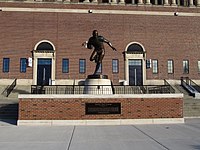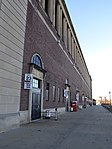
CEFCU ('sef-kyü) Stadium, formerly known as Spartan Stadium, is an outdoor athletic stadium on the west coast of the United States, located in the Spartan Keyes neighborhood of central San Jose, California. Owned by San José State University, the venue is the longtime home of Spartan football; it also hosts the university's commencement ceremony on Memorial Day weekend, and occasional high school football games. Known as Spartan Stadium for over eight decades, it was renamed in 2016.

Ohio Stadium is an American football stadium in Columbus, Ohio, on the campus of Ohio State University. It primarily serves as the home venue of the Ohio State Buckeyes football team and is also the site for the university's Spring Commencement ceremonies each May. Common nicknames for the stadium include "the Horseshoe", "the Shoe", and "the House That Harley Built".
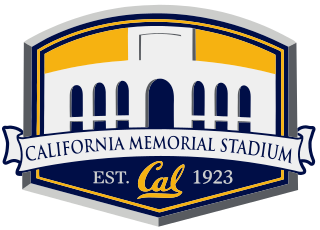
California Memorial Stadium also known simply and commonly as Memorial Stadium is an outdoor college football stadium on the west coast of the United States, located on the campus of the University of California in Berkeley, California. It is the home field for the California Golden Bears of the Pac-12 Conference.
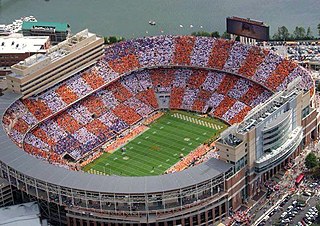
Neyland Stadium, is a sports stadium in Knoxville, Tennessee, United States. It serves primarily as the home of the Tennessee Volunteers football team, but is also used to host large conventions and has been a site for several National Football League (NFL) exhibition games. The stadium's official capacity is 101,915. Constructed in 1921 as Shields–Watkins Field, the stadium has undergone 16 expansion projects, at one point reaching a capacity of 104,079 before being slightly reduced by alterations in the following decade. Neyland Stadium is the sixth largest stadium in the United States, the eighth largest stadium in the world, and the second largest stadium in the Southeastern Conference. The stadium is named for Robert Neyland, who served three stints as head football coach at the University of Tennessee between 1926 and 1952.
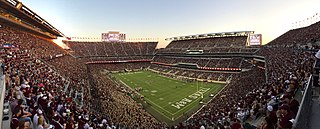
Kyle Field is the American football stadium located on the campus of Texas A&M University in College Station, Texas, United States. It has been the home to the Texas A&M Aggies football team in rudimentary form since 1904, and as a permanent concrete stadium since 1927. The seating capacity of 102,733 in 2021 makes it the largest in the Southeastern Conference and the fourth-largest stadium in the NCAA, the fourth-largest stadium in the United States, and the sixth-largest non-racing stadium in the world and the largest in Texas.

Gaylord Family Oklahoma Memorial Stadium, also known as Owen Field or The Palace on the Prairie, is the football stadium on the campus of the University of Oklahoma in Norman, Oklahoma. It serves as the home of the Oklahoma Sooners football team. The official seating capacity of the stadium, following renovations before the start of the 2019 season, is 86,112, making it the 22nd largest stadium in the world, the 13th largest college stadium in the United States and the second largest in the Big 12 Conference, behind Darrell K Royal–Texas Memorial Stadium at the University of Texas at Austin.

Darrell K Royal Memorial Stadium, located in Austin, Texas, on the campus of the University of Texas, has been home to the Longhorns football team since 1924. The stadium has delivered a home field advantage with the team's home record through November 17, 2018 being 375–117–10 (.764). The official stadium seating capacity is 100,119, making the stadium the largest in the Big 12 Conference, the seventh largest stadium in the United States, and the ninth largest stadium in the world.
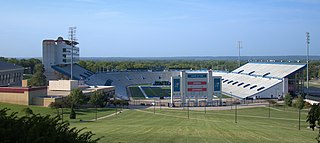
David Booth Kansas Memorial Stadium is a football stadium located in Lawrence, Kansas, on the campus of the University of Kansas. The stadium was opened in 1921, and is the seventh oldest college football stadium in the country, and is widely recognized as the oldest west of the Mississippi River. Nicknamed "The Booth", the stadium is dedicated as a memorial to Kansas students who died in World War I, and is one of seven major veterans' memorials on the campus. The stadium is at the center of all seven war memorials - adjacent to the stadium, further up the hill is a Korean War memorial honoring Kansas students who served, just a few hundred feet south of the stadium stands the University of Kansas World War II Memorial, the Kansas Memorial Campanile and Carillon, the University of Kansas Vietnam War Memorial sits adjacent to the Campanile to the west, the Victory Eagle - World War I statue located on Jayhawk Boulevard, southeast of the stadium, and the Kansas Memorial Union, a veterans' memorial that also houses the main university student union and bookstore, located east of the stadium. The stadium is the home stadium of the Kansas Jayhawks football team.

Memorial Stadium, nicknamed The Sea of Red, is an American football stadium located on the campus of the University of Nebraska–Lincoln in Lincoln, Nebraska. The stadium primarily serves as the home venue for the Nebraska Cornhuskers.
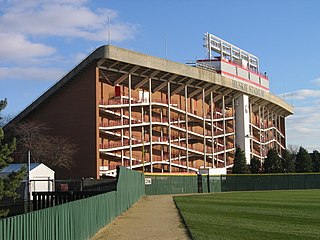
Brigham Field at Huskie Stadium is a college football stadium in the central United States, located on the campus of Northern Illinois University in DeKalb, Illinois. Opened 58 years ago in 1965, it is the home field of the NIU Huskies of the Mid-American Conference (MAC).

Jones AT&T Stadium and Cody Campbell Field, previously known as Clifford B. and Audrey Jones Stadium, Jones SBC Stadium and Jones AT&T Stadium, is an outdoor athletic stadium in the southwestern United States, located on the campus of Texas Tech University in Lubbock, Texas. Built in the style of Spanish Renaissance architecture, it is the home field of the Texas Tech Red Raiders of the Big 12 Conference.

Bill Snyder Family Stadium is a stadium in Manhattan, Kansas. It is used for American football, and is the home field of the Kansas State University Wildcats football team. It is named after the family of head coach Bill Snyder. Over the past 31 seasons – from 1990 through the 2022 season – K-State is 169–51–1 (.767) at home.

Aggie Memorial Stadium is an outdoor football stadium in the southwestern United States, located on the campus of New Mexico State University in Las Cruces, New Mexico. It is the home field of the FBS independent New Mexico State Aggies.

Faurot Field at Memorial Stadium is an outdoor sports stadium in Columbia, Missouri, United States, on the campus of the University of Missouri. It is primarily used for football and serves as the home field for the Missouri Tigers' program. It is the third-largest sports facility by seating capacity in the state of Missouri, behind The Dome at America's Center in St. Louis and Arrowhead Stadium in Kansas City. In 1972, Memorial Stadium's playing surface was named Faurot Field in honor of longtime coach Don Faurot.

Memorial Field is a football stadium located in Hanover, New Hampshire, United States. It is the home of Dartmouth Big Green football and outdoor track teams. The athletic teams at Dartmouth College compete in the Ivy League.

Kidd Brewer Stadium is a 30,000-seat multi-purpose stadium located in Boone, North Carolina. Nicknamed "The Rock," the stadium is the home of the Appalachian State Mountaineers football team. Kidd Brewer stands 3,333 feet (1,016 m) above sea level. The Mountaineers boast a 263–77–5 (.770) home record at the stadium.

Bud and Jackie Sellick Bowl is a multi-purpose stadium in Indianapolis, Indiana, United States. It opened in 1928 and is home to the Butler University Bulldogs football and soccer teams. The original seating was 36,000. It held games against the likes of the Four Horsemen of Notre Dame and Red Grange of Illinois.

Illinois Field is a baseball venue in Champaign, Illinois, home to the University of Illinois Fighting Illini baseball team. It is located in the sports complex at the University of Illinois near the Champaign-Urbana border. It is a short distance east of State Farm Center and Memorial Stadium.
Chad Richison Stadium is the on-campus football facility for the Central Oklahoma Bronchos football team in Edmond, Oklahoma. The official seating capacity of the stadium, following recent renovations, is 12,000, making the 7th largest Division II stadium, and the largest in the Mid-America Intercollegiate Athletics Association.

The Illinois–Michigan football series is an American college football series between the Illinois Fighting Illini and Michigan Wolverines. The series dates back to 1898 and features two long-time Big Ten members, with Illinois claiming five national championships, 15 Big Ten Conference titles, and 24 consensus All-Americans, and Michigan claiming 11 national championships, 44 Big Ten titles, and 85 consensus All-Americans. Michigan leads the series 72–23–2.










